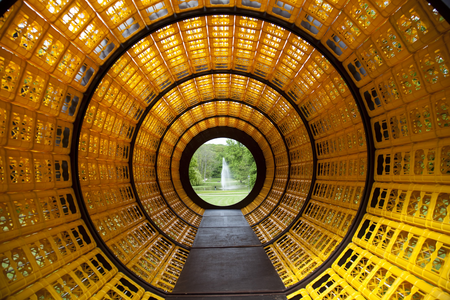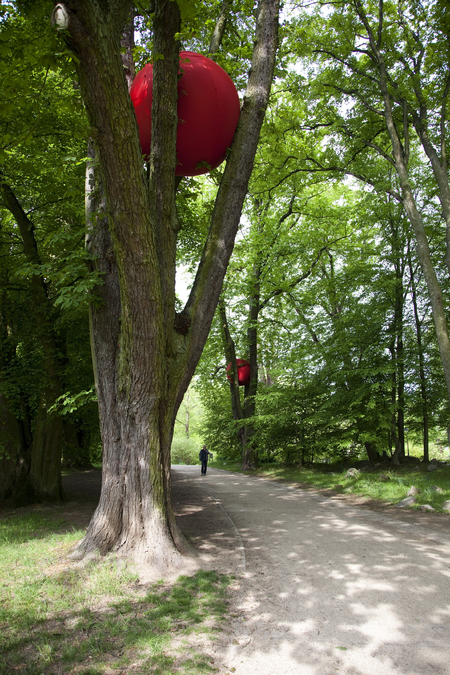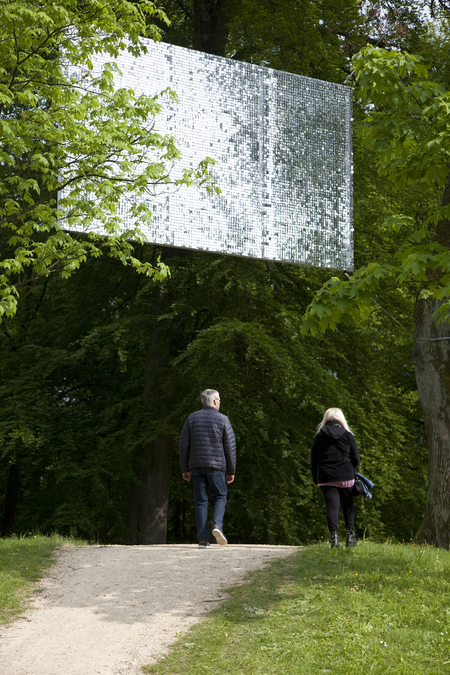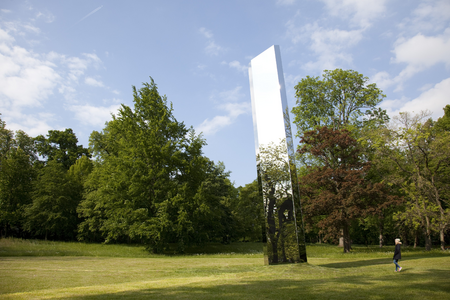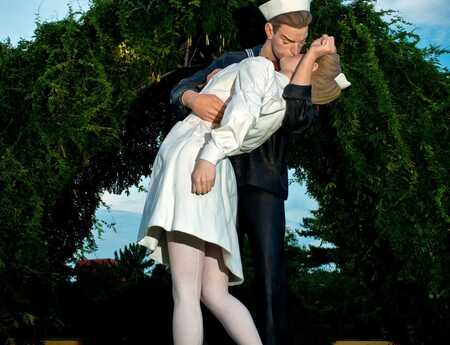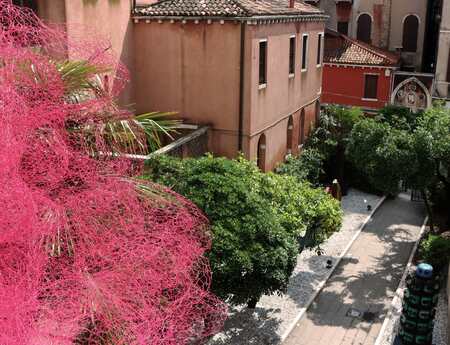Blickachsen 12 - a remarkable sculpture biennial in the Rhine-Main region
The Blickachsen 12 Sculpture Biennial offers international artists an important exhibition platform in the Rhine-Main region. An interview with Michael Zwingmann, sculptor, technical director of Blickachsen and artistic/scientific assistant at the TU Braunschweig, offers a view behind the scenes of this interesting and remarkable exhibition.
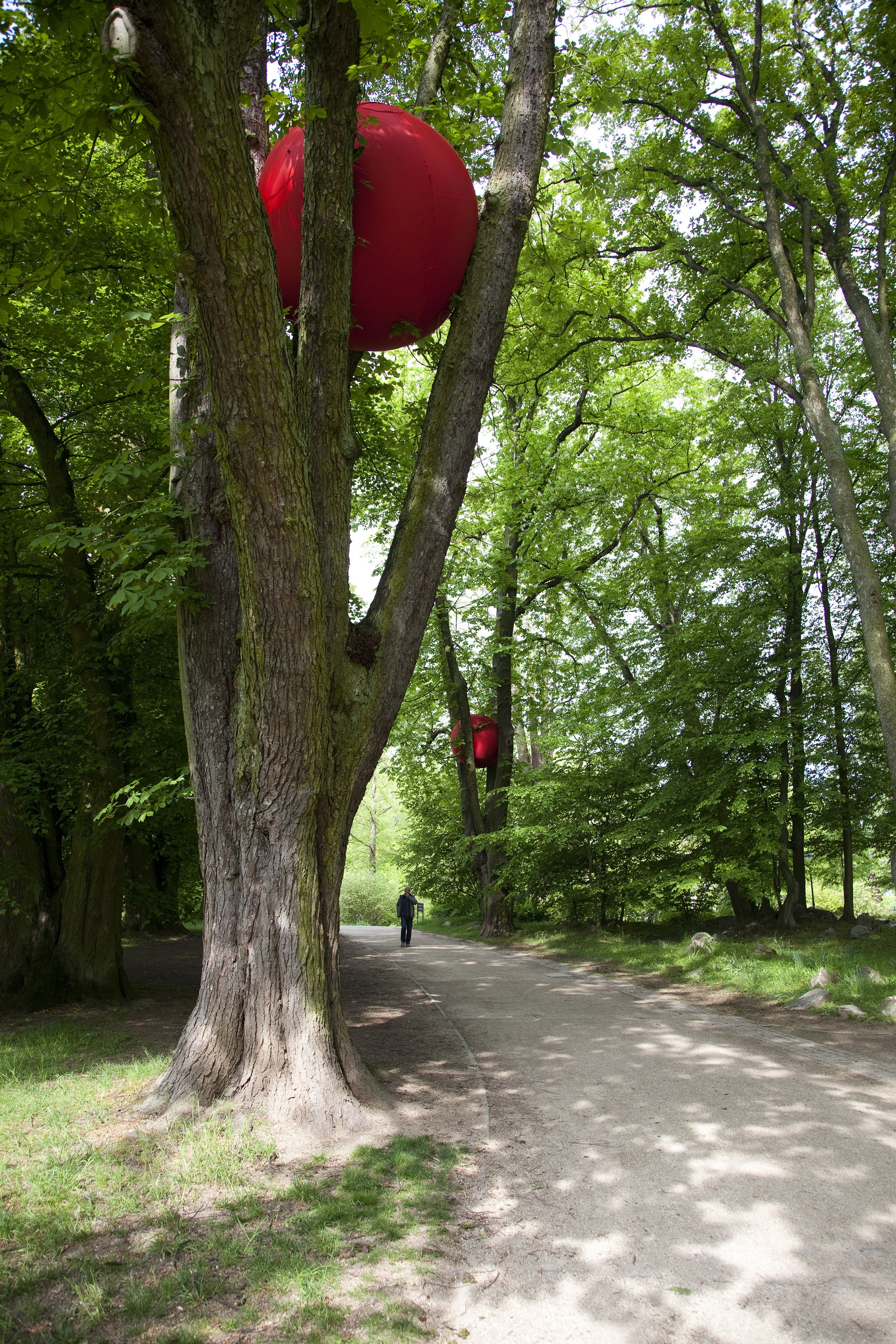
Anne Thulin, Double Dribble IV, 2019, Textil, Vinyl,
6 Teile D je 180 cm, insgesamt Masse variabel,
Courtesy Stiftung Blickachsen gGmbH,
Bad Homburg
The title Blickachsen runs through the biennial exhibition concept and has a consecutive number, currently it is Blickachsen 12. The exhibition, which features works by international sculpture artists and promising up-and-coming talents, takes place at several separate locations. In addition to the Kurpark in Bad Homburg, each exhibition seeks and presents further public spaces for the often expansive sculptures. Thus, the overall concept is always subject to change and offers visitors ever new possibilities for discovery. In the current Blickachsen, 34 works of art are exhibited at the two locations in Bad Homburg, 3 works of art in Bad Vilbel, 4 works in Eschborn, 6 in Frankfurt a.M., 9 in Kloster Eberbach and 4 in Kronberg im Taunus. The longest journey between the individual towns takes about 45 minutes.
The term "Blickachsen" goes back to the royal garden architect Peter Josef Leneé, born in Bonn 1789 and died in Potsdam 1866, who designed the Kurpark in Bad Homburg in 1856. Lenneé structured the park in the tradition of English landscape gardens, which established themselves in England in the 18th century and were also imitated in Germany. This type of park design creates a "near-natural" garden. An important feature of these gardens is to direct the observer's gaze to given points/ structures or down from vantage points by means of paths that remain open.

In the English landscape garden of Bad Homburg, visitors will therefore repeatedly encounter surprising insights or outlooks. This is reinforced by the placement of the works of art, which either appear in unusual places themselves or skilfully direct the gaze to other objects. Like a network, the connections between the works run through the park and draw attention to each other. As a visitor, one can wander between the works of art full of joy to discover and experience the works from different locations in ever new views.
Our dialogue partner at Blickachsen 12 is Michael Zwingmann. As technical director of the Blickachsen, he has agreed to give us an interview about the background of this successful sculpture biennial. We would like to thank him for the extensive information and interesting insights.
Michael Zwingmann, born in 1964 in Hanover, is a sculptor. From 1985 to 1993 he studied Fine Art at the FH Hannover and since 2007 he has been an artistic and scientific assistant at the TU Braunschweig, since 1998 a member of the Darmstadt Secession and founding member and coordinator of sculpture network.
How long have you been the technical manager of Blickachsen?
Since Blickachsen 10 in 2015, Blickachsen 2, 3 and 9 I have exhibited as a sculptor.
Was there a specific theme for the exhibition or is the title Blickachsen12 a guideline for the artists?
There is no fixed theme for the exhibition. Nevertheless, some participants took this title as an opportunity to deal with the term "Blickachsen" and to create works of art based on it. This can be seen especially in the works by Winter/Hoerbelt with Donnerstag ist alles gut (On Thursdays everything is good), in Kaarina Kaikkonen with There Must Be a Way Out of Here or Giant Log by Arik Levy, which is due to the fact that these works direct the viewer's gaze.

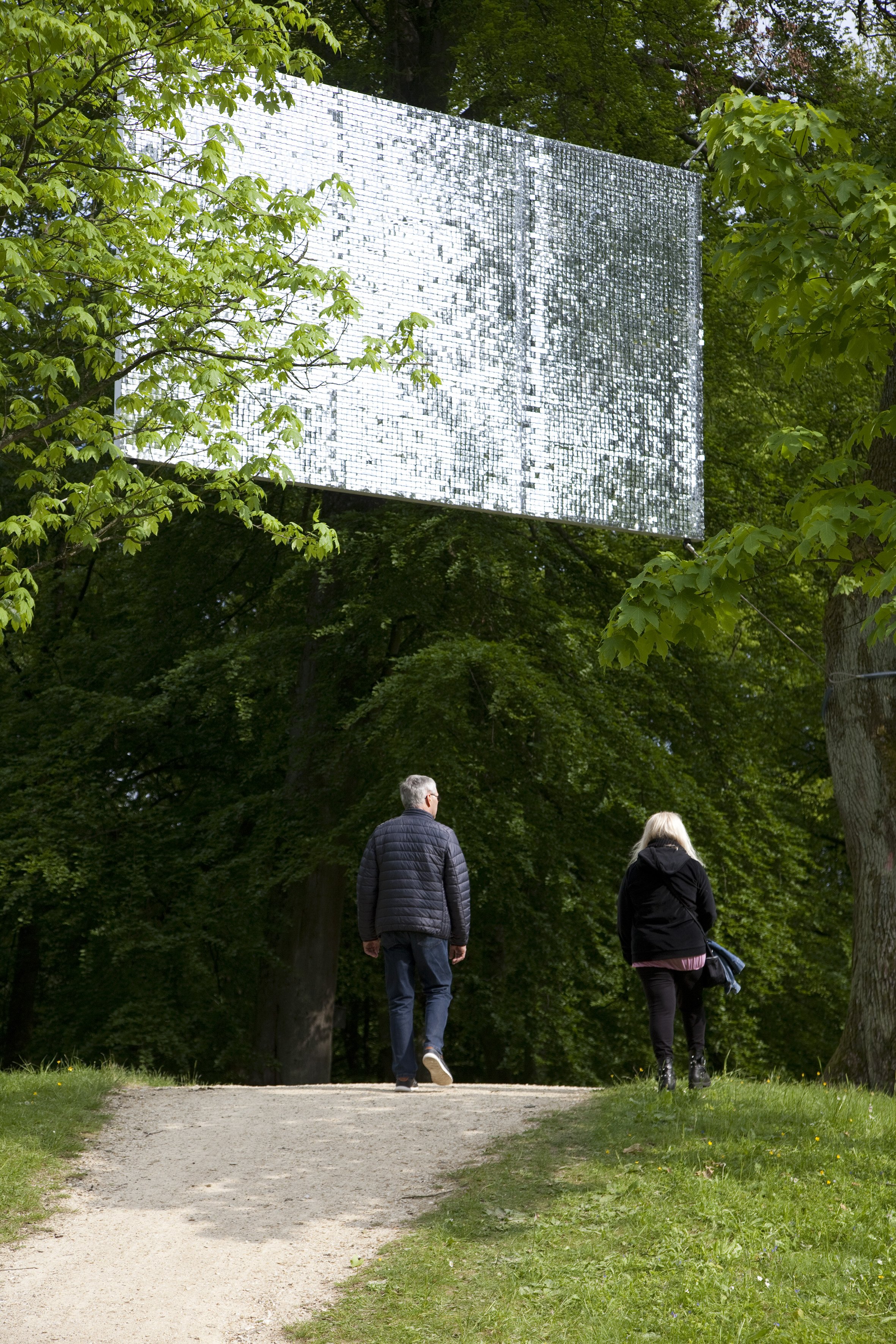
The relationship between a work of art and its surroundings is also present in the works of Katarina Löfström Open Source (16:9) and 1-Dimensional Mirror Mobile by Jeppe Hein. Both works have reflective mirror surfaces. Hein's work is also able to bring distant areas of the garden close to the viewer, to cancel out distances and to question one's own perception by blurring what is shown.
The works of Katarina Löfström and Anne Thulin result in completely different "eye axes". Double Dribble IV by Thulin consists of two tomato-red sphere-like objects anchored high up in the branches of two trees. In Löfström's work, the aforementioned "mirror", composed of many facets, is also placed high up. This circumstance distracts the viewer's gaze from the usual paths and makes three-dimensional space more tangible.
Who selected the works of art?
Except for the first Blickachsen exhibition, each had a cooperation partner. This is usually a renowned museum, and at this year's exhibition the Wanås Konst Museum from Sweden. The founder of Blickachsen, gallery owner Christian K. Scheffel, in collaboration with the team of the participating museum, here Elisabeth Millqvist and Mattias Givell, makes a selection of the artists and works. The cooperation partner receives the larger part of the exhibition. Since artists are exhibited at different museums, individuals can be seen with different works at different points of view. Jaume Plensa, David Nash, Markus Lüpertz, Erwin Wurm and Jeppe Hein, among others, were often represented at the Blickachsen.
Are there only sculptures or sculptural installations in the exhibition?
In addition to sculptures, installative works are also represented in the current exhibition. It is precisely these works that were first set up on site, such as the artwork by Winter/Hoerbelt. Installations are more dependent on the given space and its composition. Thus, the work in question unfolds a different expression depending on the installation site.
Are there walk-in/usable or interactive works among them?
Arik Levy's large work in the Kurpark is often used as a "self-stage" and Jeppe Hein's rotating mirror can also be seen as an interactive element. On Thursdays everything is good from Winter/Hoerbelt can and should be entered by the visitors.
On the positioning of the works: Are the artists involved in the positioning process? How difficult are the works to set up?
Most of the artists are present at the site when the works are put up.
The works by Kaarina Kaikkonen, Winter/Hoerbelt and Arik Levy were the most complicated to set up.
This was because Winter/Hoerbelt's work had to have a very symmetrical structure in order to be shown to its best advantage. Individual parts were assembled and connected on site, seven people were employed for about a week.
Kaarina Kaikkonen's expansive work was anchored to the sides in pre-assembled units using two lifting platforms. The difficulty in setting up Arik Levy's work was that the stainless steel surface of the plant was polished to a high gloss and should therefore be treated with care. At the same time, the plant weighed approximately 9 tons and stood 13 metres high. Several concrete bases had to be embedded in the ground for anchoring.
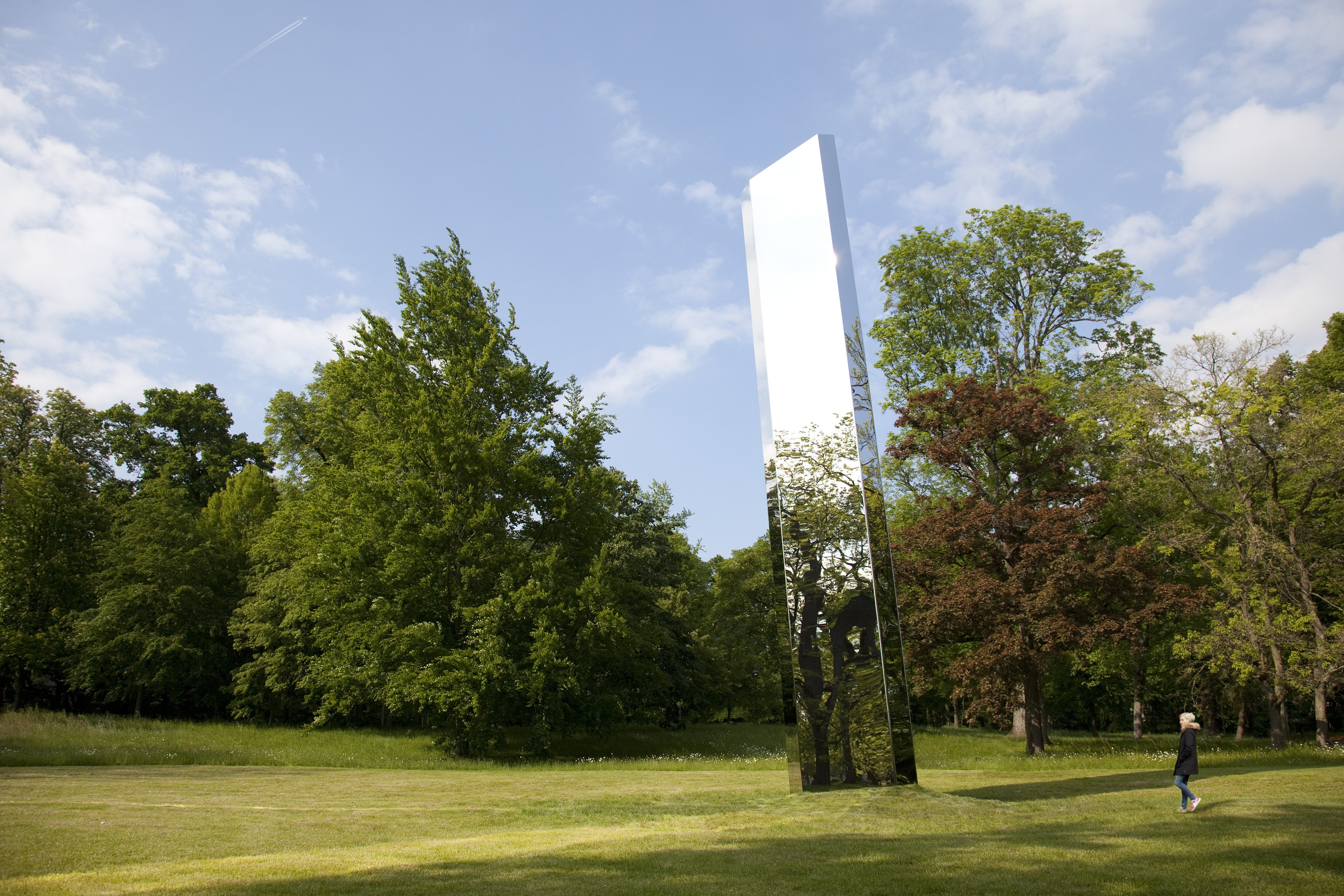
Bad Homburg
How long did it take to construct the entire structure?
The construction of the entire exhibition began at the end of March and took about two months. On average, eight people were involved.
What happens to the works after they have been dismantled? Or will the works remain in the Blickachsen area as a donation/permanent loan?
All the works will be disassembled and the anchors and plinths will be dismantled. Most sculptures will be returned to their original location. The site must be free for the new artworks of the next Blickachsen exhibition. An artwork has been purchased and donated over time by a private individual with the request that it remain at its location.
How are the Blickachsen financed?
The number of exhibits and the associated costs have increased considerably over the years. Therefore, it is important that the exhibition is supported by various sponsors from the region and the state of Hesse.
At each Blickachsen exhibition in September, the Friends of the Blickachsen will award the art prize of 5000€ to one of the participating artists. In 2017, at Blickachsen 11, Alicja Kwade with Big Be-Hide was awarded the prize by the top-class jury. The award ceremony always takes place in September. This year's prize will be awarded to Katarina Löfström in Bad Homburg Kurpark on 13 September 2019 at 6 p.m. The barrier-free exhibition, which is open around the clock, ends on 6 October 2019 and is highly recommended not only for friends of three-dimensional art. Visit Blickachsen 12 and find your personal favourite among the various sculptures and installations.
It's worth looking!
Author: Dr. Eva Daxl
Eva Daxl studied art with a focus on sculpture. In her PhD thesis she wrote about ceramic materials in art criticism. She is therefore familiar with three-dimensional works of art in theory and practice.
Titel: Winter Hoerbelt, Donnerstags ist alles gut, 2019, 900 Getränkekisten GDB Sonderfarbe, 440x400x1125 cm, Courtesy Stiftung Blickachsen gGmbH, Bad Homburg

